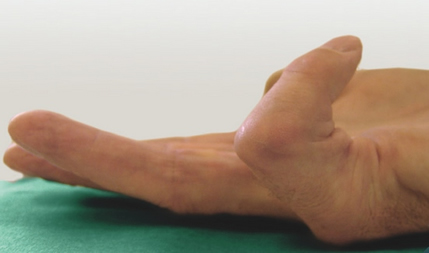Is hand splinting beneficial for Dupuytren disease?
It probably depends on the situation whether wearing a hand splint is beneficial or not. Below comments mostly refer to static night splints, which do not press or pull on the finger. Their pupose is only to avoid curling of the finger(s) at night and thus avoiding further contracture. The other type of hand splints are dynamic splints that exercise force onto the finger and try to reduce contracture by doing so. Below we are showing examples of both types of splints.
Hand splints are often worn after hand surgery (typically a fasciectomy), needle fasciotomy (abbreviated as NA or PNF) or collagenase injection (brand name Xiaflex or Xiapex). They are worn mostly at night, while - for s shorter period of time - some are also worn during the day. Wearing a splint day at night over a longer period of time (weeks) is usually not recommended because eventually the joints may become stiff. The form of the splints is varying strongly, some are standard products, others are individually manufactured and adapted.
The benefit of long term splinting, i.e. over months and years, is currently still being disussed controversy_on_splinting because clear evidene is still missing. For the time being we only have a few, somewhat meaningful studies or trials. Most of them investigated the use of splints after surgery finding no benefit. The use after minimal surgery that removes only a part of the cord, e.g. segmental aponeurectomy, has not been investigated yet. Also the benefit after needle fasciotomy has not been demonstrated in a trial but there is a series of positive case reports from patients and doctors. For example patients report that wearing a night splint regularly after needle fasciotomy avoided recurrence of the contracture. It may be that splinting after surgery, where the cord is fully removed, is not beneficial but it is beneficial after minimal invasive breaking of the cord by needle fasciotomy or collagenase injection.
The goal of wearing a (night) splint long term is generally to improve the result of the previous treatment and to avoid or postpone recurrence of the contracture. Avoiding recurrence completely might not be possible because Dupuytren disease is in the genes and for the time being we have no means to fully cure Dupuytren's. Therefore the goal is improving symptoms and slowing down progression.
Occasionally splints are also used as an attempt to prevent contracture without prior treatment.
A positive example of the effect of static night splinting
Several impressive case studies have been published but it has to be kept in mind that those are selected individual cases and it is not sure whether or under which conditions another patient would achieve similarly good results. .Below example shows an excellent result after needle fasctiotomy (NA, PNF). It was provided by Dr. Albrecht Meinel, Dupuytren-Ambulanz, Germany. In this case wearing a night splint regularly even improved the outcome of the NA. Please do not expect that this is always the case!
Prior to NA:
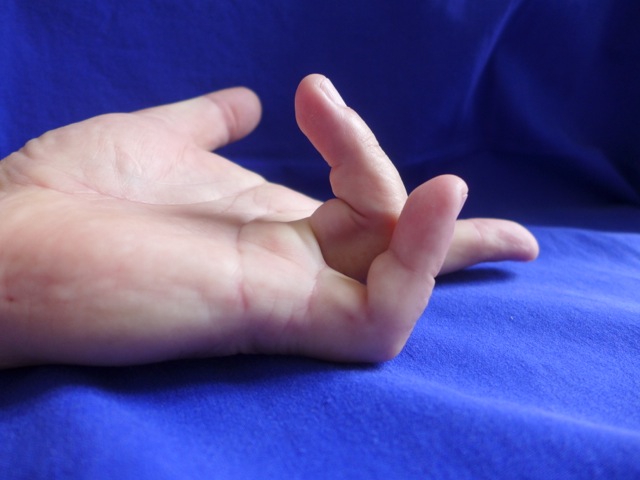
Immediately after NA:
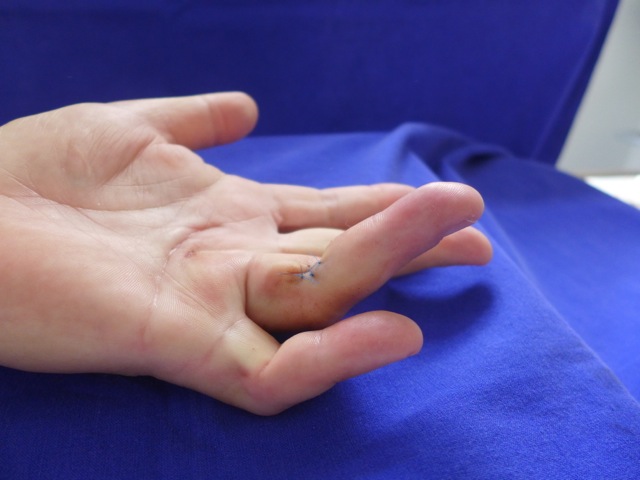
After 2.5 months of static night splinting:
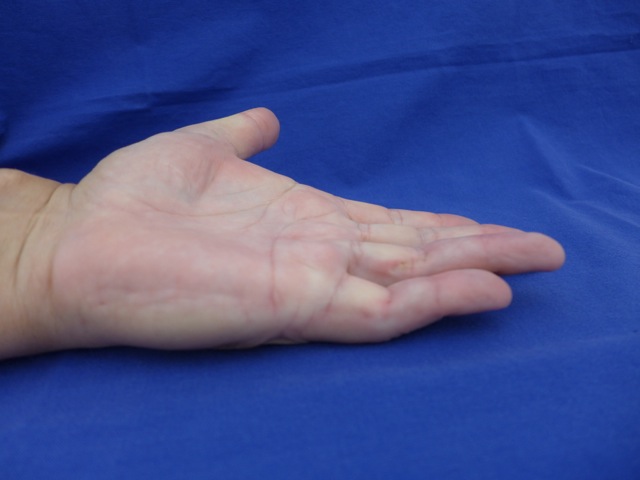
After 2.5 years of static night splinting:
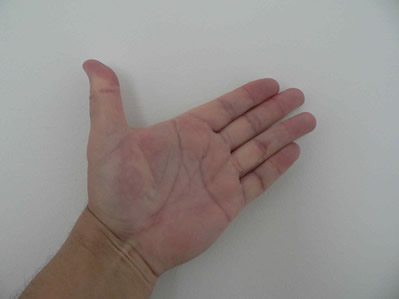
When and how long should a night splint be worn?
After needle fasciotomy (NA) or collagenase injection, where the cord is broken but not removed, regularily wearing a night splint might help postponing recurrence of the contracture. Individually it is unfortunately very difficult or impossible to predict how the disease progresses and how effective a night splint will be. Because wearing a night splint is not dangerous and has no severe side effects it might be at least worth a try to preserve or even improve the result of the treatment.
The results of available trials and case reports can be summarized as below.
-
There is some indication that wearing a night splint can prevent contracture. But this is only effective as long as the splint is worn link
-
Wearing a night splint long term in addition to hand therapy after a first surgery (fascietomy) is probably not required. This might be different after operating a recurrent contracture. In special cases the doctor will decide whether or not and how long a splint should be worn.
-
A night splint is probably beneficial after
-
surgery of a recurrent contracture
-
minimally invasive treatments that do not remove the cord (NA/PNF and collagenase injection), especially if the patients tends to suffer from early recurrence.
-
There does not seem to be a fixed period after which the night splinting can safely be abandonded and the finger then won't contract anymore. When splinting is stopped in many cases the contracture will come back within months. Supposedly one would have to wear the splint forever to avoid or postpone recurrence.
What types of splints are available?
Static night splints
Below are two examples of static night splints but there is an unlimited variation of splints because they are often individually manufactured and adapted. We believe that is is crucial that the splint is very comfortable and very easy to put on and off. Otherwise the patient will soon stop wearing it.
Below is a simple shell to splint the PIP joint of a little finger. The shell is made of thermoplastic material, is adapted to the contracture and is at night simply shifted onto the finger.

Below a pre-facricated standard splint (Fixxglove ®). It is built as a glove and washable, which is useful when wearing it over a longer period of time. The three mostly affected fingers are splinted in a slightly spread position. That might included fingers without contracture. Splinting is achieved by the (white) metal inlay which is mounted onto the glove. In this case the metal plate is on the palm side but there are also models whith inlays on the outer side of the hand. In cases with a residual contracture the splint is adapted by bending the metal inlay and thus avoiding pressure on the affected joint.
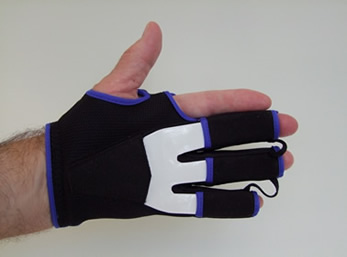
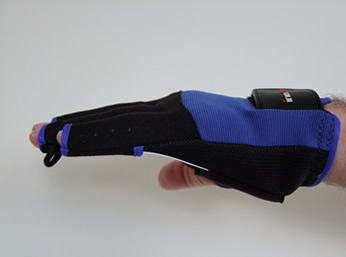
Comfortable night splint (viewed from the palm (left) and from the side). It splints the three fingers mostly affected by Dupuytren contracture. Pictures provided by Dr. A. Meinel, Dupuytren Ambulanz, Germany.
Dynamic day splints
Below a splint (Bunnell splint) that is also worn during parts of the day. It produces a force onto the finger to keep it straight. Picture provided by Dr. Jeffrey Wint of the Handcenter of Western Massachusetts.
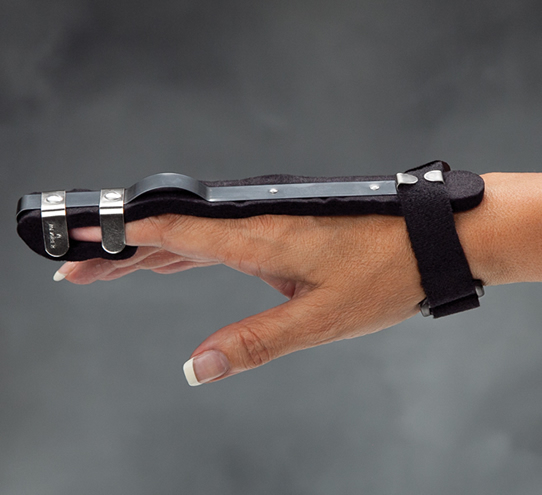
A patient provided us with below pictures of a dynamic splint that he himself developed. This splint is worn only during the day and typically twice a day for 3 hours. Now, two years after PNF, he reduced the time per day but still uses it daily. This splint actively stretches the finger but still allows do bend it when needed. Below picture illustrates the basic operation.
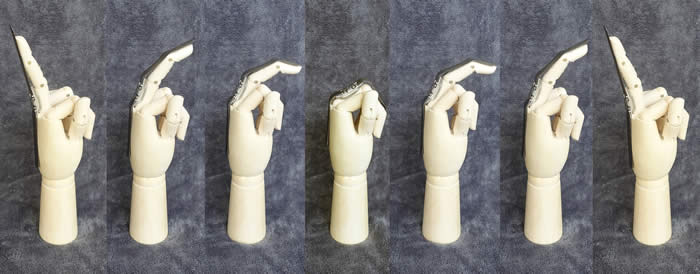
Splint applied to the hand:
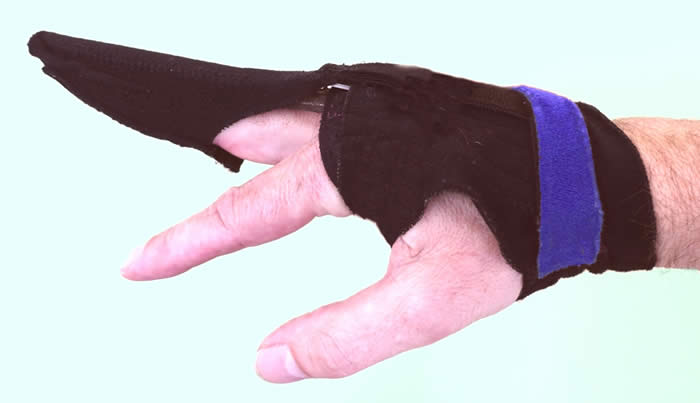
For this patient the effect of his dynamic splint is amazingly good. Please note that this is not neccessarily also so for other patients.
Prior to NA (Tubiana stage 3-4):
After NA (with skin transplant, Tubiana stage 1-2):
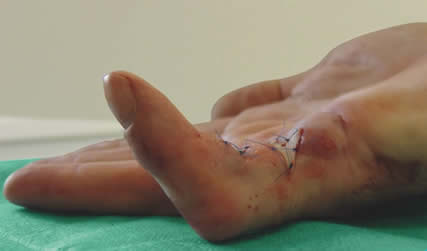
After 8 months of dynamic splinting (Tubiana stage 0):
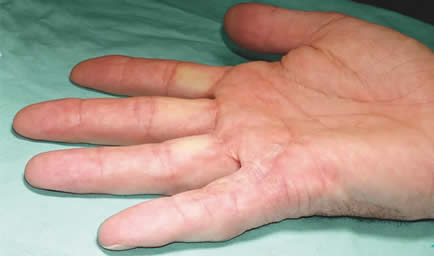
Some literature on splinting
- Ball C, Nanchahal J (2002) The use of splinting as a non-surgical treatment for Dupuytren’s disease: a pilot study. Br J Hand Ther 7:76–78 abstract
- Chojnowski A., Wach W., Degreef I. (2017) Controversy: Splinting for Dupuytren Contracture. In: Werker P., Dias J., Eaton C., Reichert B., Wach W. (eds) Dupuytren Disease and Related Diseases - The Cutting Edge. Springer, Cham. p 323-329. abstract
- Collis J, Collocott S, Hing W, Kelly E (2013) The effect of night extension orthoses following surgical release of dupuytren contracture: a single-center, randomized controlled trial. J Hand Surg Am 38A:1285–1294 abstract
- Degreef I, Brauns A (2016) Splinting as a therapeutic option in Dupuytren contractures. In: Werker PMN, Dias J, Eaton C, Reichert B, Wach W (eds) Dupuytren Disease and Related Diseases – The Cutting Edge. Springer, Cham, pp 357–361Google Scholar
- Jerosch-Herold C, Shepstone L, Chojnowski AJ, Larson D, Barett E, Vaughan SP (2011) Night-time splinting after fasciectomy or dermofasciectomy for Dupuytren’s contracture; a pragmatic, multi-centre, randomized controlled trial. BMC Musculoskelet Disord 12:136 full_paper
- Kemler MA, Houpt P, van der Horst CMAM (2012) A pilot study assessing the effectiveness of post-operative splinting after limited fasciectomy for Dupuytren’s disease. J Hand Surg Eur Vol 37E:733–737 abstract
- Larocerie-Salgado J, Davidson J (2011) Nonoperative treatment of PIP flexion contractures associated with Dupuytren’s disease. J Hand Surg Eur Vol 37E:722–727 abstract
- Meinel A (2011) [Long-term static overnight extension splinting following percutaneous needle fasciotomy]. [Article in German]. Handchir Mikrochir Plast Chir 43(5):286–288 abstract
- Meinel A (2012) The role of static night splinting after contracture release for Dupuytren’s disease: a preliminary recommendation based on clinical cases. In: Eaton CH et al (eds) Dupuytren’s disease and related hyperproliferative disorders. Springer, Heidelberg/New York, pp 333–339 abstract
- Rives K, Gelberman R, Smith B, Carney K (1992) Severe contractures of the proximal interphalangeal joint in Dupuytren’s disease: results of a prospective trial of operative correction and dynamic extension splinting. J Hand Surg Am 17(6):1153–1159 abstract
Page last revised: 2/19/18
